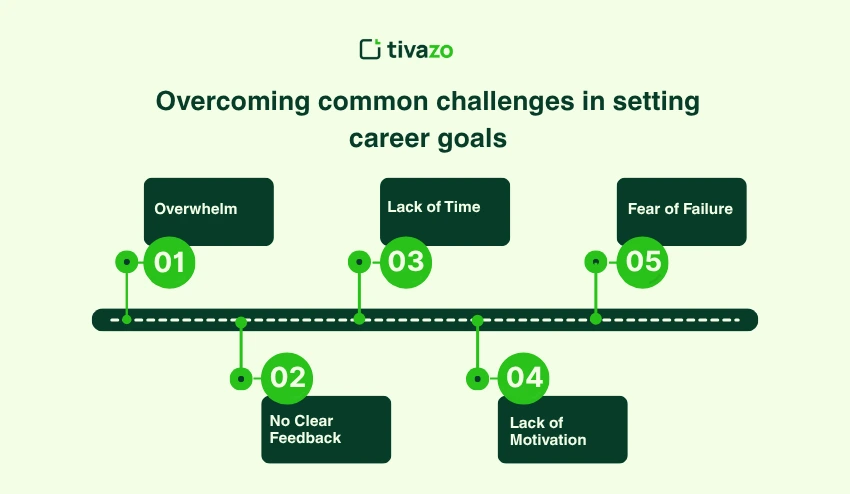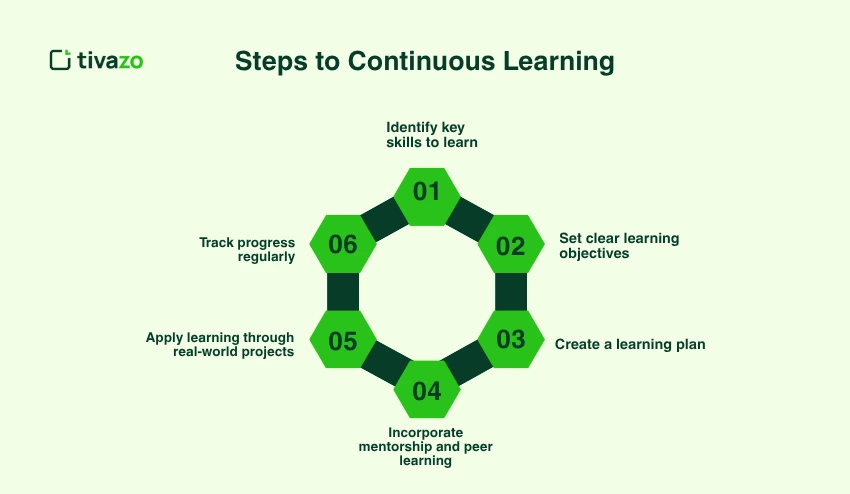You should have a plan in case you want to get faster promotions, improved job fit or an opportunity to better understand the route to leadership. Setting career goals transforms the where hopes into what. Specific targets make your education more purposeful, assist you in selecting the correct professions, and networking meaningful, as well as allowing you to quantify the progress. Studies indicate that structured goal setting and regular progress monitoring has a great influence in enhancing the likelihood of attaining goals.
This is the guide that will provide you with seven effective and practical steps in designing career goals that stick today.
Key Highlights:
- What is setting career goals
- Career Goal Examples
- Proven Steps to Set and Achieve Career Goals
- Overcoming common challenges in setting career goals
- Importance of continuous learning
- Staying committed to your career goals
- Setting career goals with your personal life
What is setting career goals?
Setting career goals is the process where one identifies specific targets that they want to accomplish in their professional career and the steps involved in accomplishing them. It assists in giving you a road map and this keeps you focused and on course. The career goals might be based on new skills and certifications to become leaders or even change the occupation altogether.
Establishing career goals are simply setting career goals. This will keep you on track with your long term goals and will help you find your purpose in the day to day running of your life and make it all real.
5 Career Goal Examples
To achieve long term success, it is important to setting career goals. Below we have provided five examples of career goals, which will motivate you and each one of these is different at various phases of your career. These objectives can assist you to remain concentrated and evaluate how much you have accomplished whether you are only beginning or seeking to be a leader.

- Become a Subject Matter Expert (SME)
Being seen as a specialist raises the former and gives you opportunities to work more. - Achieve a Leadership Position
Graduating to a position of management will assist you to develop and impact other people in your organization. - Enhance Communication Skills
Teamwork is enhanced by effective communication, and it makes you improve in your profession. - Learn a New Technical Skill
Having technical competencies will make you competitive and flexible in the field. - Work-Life Balance Improvement
Having a balance between the work and personal life leads to higher satisfaction and long-term productivity.
What good career goals look like
Good career goals are precise, quantifiable, attainable, pertinent and time-sensitive. That is the SMART framework. The SMART acronym can be traced back to the model provided by George T. Doran in 1981 and is the easiest method of ensuring that the goal you have is achievable. SMART is used to prevent fuzzy vague goals that cannot be measured.
7 Proven Steps to Set and Achieve Career Goals
Steps of achieving and setting career goals are:

Step 1: Reflect on your career aspirations and identify core values
It is always best to know what will motivate you in your career before setting career goals. It is always good to look back at what you want to be so you can see what skills you wish to apply and what kind of lifestyle you would wish to have. This self-knowledge makes sure that the goals you will have will be in line with your values which improves probability of long term motivation and contentment.
- Ask yourself: what jobs do I find energised by, what are my preferred skills to utilise and what are my desired lifestyle?
- List 3 nonnegotiables (such as autonomy, meaningful impact, flexible hours).
- Write a short 5–10 year career vision sentence: “ Within 7 years, I will be leading a product team in a mission-oriented organization, doing client work and one talk per year to an audience.
Why this matters: Goals that are in line with the core values way have greater chances of ensuring that you stick to it and see it through.
Action: Take 20-30 minutes to write your values and 7 year vision. Keep that somewhere you will see it once every week.
Step 2: Set clear and achievable short-term goals (next 6–12 months)
Short term goals serve to fill the gap between the present and the intended destination. They are the stepping stones towards your future career goals and offer the instant focus and encouragement that you should have. They assist you in making small but daily steps that will turn out to be big.
- Pick 2–3 short-term goals which are immediately beneficial to your long term vision.
- Make them specific, such as, finish by June the Advanced Data Analytics certification, instead of study data skills.
- Assign deadlines and first 3 things that you will do.
Why this matters: Short-term goals create momentum and quantifiable victories, which subsequently create confidence.
Actions: register by February 10; finish Module 1 by March 15; plan 2 sessions of studying once a week.
Step 3: Create SMART goals for career development
SMART goals are an efficient means of ensuring your career objectives are precise, goal-related and attainable. By making your goals SMART, you are guaranteed of making all your goals realistic, and actionable with accountability and quantifiable results. This method is common with practitioners and it is among the best methods of keeping track.
- Specific: What in specific terms are you going to do?
- Measurable: How will you help track it? (KPIs, pass a test, publish X articles)
- Achievable: Can you make it with your schedule and resources?
- Relevant Does it carry you toward your vision?
- Time-bound: When are you going to be done?
SMART example: To become a Senior Analyst by December 2026 by having completed two cross-functional projects that would result in a 5% retention boost and passed the leadership training course by the end of September 2026.
Why this matters: SMART goals demand clarity and can measure progress. Career experts and managers recommend the use of the SMART framework extensively.
Step 4: Focus on long-term career objectives (5–10 years)
Although short-term objectives are crucial in providing a boost of immediate improvement, the long-term career goals enable you to look at the bigger picture. These goals must be depictive of your aspirations in the end in your career and act as benchmarks to determine your career path in life. It is also possible to make better decisions and keep yourself motivated in the long term by having clear long-term goals.
- Translate your 7–10 year vision into 2-3 career goals (e.g. get to industry management, establish a consultancy, or become a published thought leader).
- Break each objective into milestones, learning, positions to assume, connections goals and results..
Why this matters: Daily work has a direction because of long-term goals. They enable you to consider job changes in a proactive rather than reactive way.
Action: Construct a milestone roadmap and approximate dates and experiences needed by each milestone.
Step 5: Build accountability and seek support
The success of an organization depends on accountability. Having someone to call on can help you become more serious about sticking to your objectives. A safety net comes with seeking advice or mentorship by your peers and you are sure to remain on track and also learn. When the going gets rough, there are support systems that provide guidance, encouragement and support.
- Find a mentor or sponsor that is knowledgeable about the ability and path you desire. Mentorship enhances retention and career advancement by a significant percentage. Large numbers of mentoring programs claim improved retention and job satisfaction of participants.
- Join a peer accountability team or mastermind.
- Share your goals with with close workmates or friends that will get them to keep you responsible.
Action: Find the appointment with a potential mentor, to have a call that lasts 30 minutes, during the week and arrange a weekly 30-minute check-in.
Step 6: Adjust your goals and be open to change
Goals ought to be changing with you as you advance in your career. Something that was applicable yesterday may not be the same way today. A periodic reconsideration of your objectives makes sure that they are in line with your development, as well as with the shifting needs of your professional sphere. In order to be successful in the long term, flexibility is vital.
- Revisit goals every quarter. Instruct them where the expectations of new roles are different or you get to know more about what you have strengths and likes.
- Use data to guide pivots: in case a pathway is not progressing you towards quantifiable goals then change it.
Why this matters: Flexibility will keep you realistic and focused to a new opportunity when your plan can become frustrating.
Action: Ask: “What worked? What didn’t? What is the next thing that I will change in quarter?
Step 7: Track and measure your progress regularly
To make sure that you are on the way to the right direction, it is important to track your progress. It is not hard to lose track of your goals and forget them without frequent check-ins. Consistent measurement helps you to adjust, enjoy your wins, and get motivated.
- Adopt a progress system you will use consistently: a journal every week, an OKR board, a tracking tool. Studies indicate that tracking progress will help you achieve more goals, again, as long as your progress is assigned and shared.
- Use metrics: progress in terms of networking calls made, certifications passed, project delivered, promotion discussions. Celebrate micro-wins.
Action: Choose a simple tracking tracker and create a list of columns today with following categories: Goal, Metric, Deadline, This Week actions, Progress.
Overcoming common challenges in setting career goals
There are usually challenges in your way to career objectives. Though having goals is critical to growth, the process may be cumbersome at times because of different challenges. These challenges should be identified and dealt with in order to keep up with the pace.

1. Overwhelm
It is true that when one is given big goals, the sheer amount of tasks becomes overwhelming.
Solution: Subdivide goals into 15-30 minute action blocks.
Daily concentrate on one little action to avoid the sense of being overwhelmed and achieve gradual progress.
2. No Clear Feedback
The absence of feedback may help to make it difficult to measure improvement and progress.
Solution: Mentors and frequent follow-ups.
Ask to be mentored and give effective feedback. This enhances job satisfaction and job retention.
3. Lack of Time
People are not able to concentrate on their goals because of the time constraints.
Solution: Reallocate your time.
Monitor your daily time use and invest 2 hours a week in high-impact activities.
4. Lack of Motivation
It is easy to lose your motivation, particularly when things do not seem to be happening.
Solution: Do it in small and manageable steps.
Reward partial accomplishments in between to keep oneself energized, and be propelled towards greater heights.
5. Fear of Failure
The fear of errors can make one afraid to take risks and make a step.
Solution: Reach out to failure as feedback.
See the failures as your lessons, change, and go on with your achievements confidently.
The importance of continuous learning in setting career goals
The quickest method of turning your life around is to develop competencies. Find 2 high-impact abilities in the 12 months to come and create an educative plan that combines brief courses, projects, and mentorship. Employers cherish the learning opportunities: those employees who are able to get access to growth programs have higher retention and satisfaction.
Steps to Continuous Learning:

1. Identify key skills to learn
You can select a 2-3 high impact skills that will further your career, be it leadership, coding, or project management.
2. Set clear learning objectives
Write down what you want to accomplish by each skill. While staying with the example, one can say such goals as: Do an online course on data analytics or Be able to lead a cross-functional team project by the end of Q3.
3. Create a learning plan
Divide your learning into smaller medical parts, including weekly online lessons, monthly practical projects, or four times of year feedback discussions.
4. Incorporate mentorship and peer learning
Request assistance of people who can offer you feedback and experience in your progress, along with likelihood of collaboration and development.
5. Apply learning through real-world projects
Participate in work projects either in place or out of place where you can put into practice what you have learned. This assists in cementing knowledge and improving practice.
6. Track progress regularly
Check your learning every month to make sure that you are progressing. Modify your strategy accordingly in response to changing interests or objectives.
Building resilience: staying committed to your career goals
A crucial aspect of living a career that is focused is resilience in that your career goals should have you committed particularly during the down turns. It is the result of building the tiniest, steady practices, being around people who stick with you, as well as, keeping track of your developments. In case of mishaps, take them as lessons and not failures which will aid you in learning and developing.
Remember that the development of resilience is a process it is about setting career goals and healthy habits to enable you to recover on a more powerful scale every time you encounter obstacles. With your mentor and accountability group, you should always seek guidance and support in trying time hence you should seek their support when the motivation is low.
Setting career goals with your personal life for balance
It is not the success of a career that makes you lose your health or a love interest. Keep limits and develop objects that do not violate your personal priorities. Compare job preferences with values list Step 1.
Practical templates and quick examples
SMART template you can copy:
- Goal: [Specific action] within November 7, 2025, with measure [metric].
- Example: “Publish 6 case studies on LinkedIn by Dec 1: will be determined by writing one case study every three weeks and turning two of those case studies into pieces in the newsletter.”
Weekly tracker columns:
Goal | This week’s action | Time budget | Progress % | Roadblock
Quarterly review prompts:
- Has this objective made me closer to my 1-year target?
- What was one of the skills that I developed in this quarter?
- What will I quit doing next quarter?
Conclusion: Start Today, Adjust Constantly, Win Consistently
Setting career goal does not simply involve fantasizing the quantification of success, but also taking active initiatives in realizing the same. Adhering to the seven steps that are given in this guide, you will have a definite career map. Setting career objectives enables you to convert your miscellaneous visions into quantifiable behaviors.
By putting your career ambitions into focus, you ambition and resolve to achieve your career goals, by setting career goals (long term and short term), and instilling accountability in your goals, you will succeed in your career. AL Be flexible, monitor your progress, and not to forget to celebrate the small wins along the way. It is important to bear in mind that career goal-setting is not a one-time process, but it evolves along with you.




